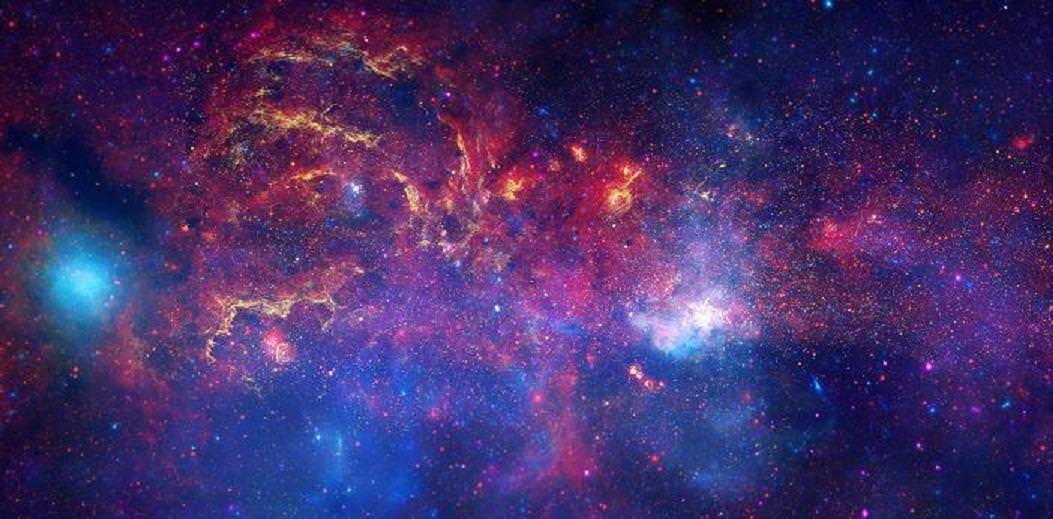During the 1970s, astronomer became aware of a massive radio source at the center of our galaxy that they later realized was a Supermassive Black Hole (SMBH) - which has since been named
Sagittarius A*
. And in a
recent survey
conducted by
NASA's Chandra X-ray Observatory
, astronomers discovered evidence for hundreds or even thousands of black holes located in the same vicinity of the Milky Way.
But, as it turns out, the center of our galaxy has more mysteries that are just waiting to be discovered. For instance, a team of astronomers recently detected a number of "
mystery objects
" that appeared to be moving around the SMBH at Galactic Center. Using 12 years of data taken from the
W.M. Keck Observatory
in Hawaii, the astronomers found objects that looked like dust clouds but behaved like stars.
The research was conducted through a collaboration between Randy Campbell at the
W.M. Keck Observatory
, members of the
Galactic Center Group at UCLA
(Anna Ciurlo, Mark Morris, and Andrea Ghez) and Rainer Schoedel of the
Instituto de Astrofisica de Andalucia (CSIC)
in Granada, Spain. The results of this study were presented at the
232nd American Astronomical Society Meeting
during a press conference titled "The Milky Way & Active Galactic Nuclei".
[caption id="attachment_139440" align="aligncenter" width="580"]
Pictured here are members of GCOI in front of Keck Observatory on Maunakea, Hawaii, during a visit last year. Credit: W.M. Keck Observatory
[/caption]
As Ciurlo explained in a recent W.M. Keck
press release
:
The researchers made their discovery using 12 years of spectroscopic measurements obtained by the Keck Observatory's
OH-Suppressing Infrared Imaging Spectrograph
(OSIRIS). These objects - which were designed as G3, G4, and G5 - were found while examining the gas dynamics of the center of our galaxy, and were distinguished from background emissions because of their movements.
"We started this project thinking that if we looked carefully at the complicated structure of gas and dust near the supermassive black hole, we might detect some subtle changes to the shape and velocity," explained Randy Campbell. "It was quite surprising to detect several objects that have very distinct movement and characteristics that place them in the G-object class, or dusty stellar objects."
Astronomers first discovered G-objects in proximity to Sagittarius A* more than a decade ago - G1 was discovered in 2004 and G2 in 2012. Initially, both were thought to be gas clouds until they made their closest approach to the supermassive black hole and survived. Ordinarily, the SMBHs gravitational pull would shred gas clouds apart, but this did not happen with G1 and G2.
[caption id="attachment_139441" align="aligncenter" width="580"]
3-D spectro-imaging data cube produced using software called OSIRIS-Volume Display ( OsrsVol) to separate G3, G4, and G5 from the background emission. Credit: W.M. Keck Observatory
[/caption]
Because these newly discovered infrared sources (G3, G4, and G5) shared the physical characteristics of G1 and G2, the team concluded that they could potentially be G-objects. What makes G-objects unusual is their "puffiness", where they appear to be cloaked in a layer of dust and gas that makes them difficult to detect. Unlike other stars, astronomers only see a glowing envelope of dust when looking at G-objects.
To see these objects clearly through their obscuring envelope of dust and gas, Campbell developed a tool called the OSIRIS-Volume Display (OsrsVol). As Campbell
described it
:
UCLA Astronomy Professor Mark Morris, a co-principal investigator and fellow member of UCLA's Galactic Center Orbits Initiative (GCOI), was also involved in the study. As he
indicated
:
[caption id="attachment_97109" align="aligncenter" width="580"]
A binary star system potentially on the verge of a stellar collision. Credit: Chandra
[/caption]
After examining the objects, the team noticed that there was a great deal of energy was emanating from them, more than what would be expected from typical stars. As a result, they theorized that these G-objects are the result of stellar mergers, which occur when two stars that orbit each other (aka. binaries) crash into each other. This would have been caused by the long-term gravitational influence of the SMBH.
The resulting single object would be distended (i.e. swell up) over the course of millions of years before it finally settled down and appeared like a normal-sized star. The combined objects that resulted from these violent mergers could explain where the excess energy came from and why they behave like stars do. As Andrea Ghez, the founder and director of GCOI, explained:
Looking ahead, the team plans to continue following the size and shape of the G-objects' orbits in the hopes of determining how they formed. They will be paying especially close attention when these stellar objects make their closest approach to Sagittarius A*, since this will allow them to further observe their behavior and see if they remain intact (as G1 and G2 did).
This will take a few decades, with G3 making its closest pass in 20 years and G4 and G5 taking decades longer. In the meantime, the team hopes to learn more about these "puffy" star-like objects by following their dynamical evolution using Keck's OSIRIS instrument. As Ciurlo
stated
:
And be sure to check out this video of the presentation, which takes place from 18:30 until 30:20:
https://files.aas.org/aas232/aas_232_press_2018-06-06_15_00_the_milky_way_and_active_galactic_nuclei.mp4
Further Reading: Keck Observatory
 Universe Today
Universe Today
